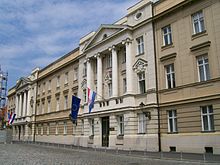1990 Croatian parliamentary election
The election took place during a political crisis within the Yugoslav federation, the disintegration of the League of Communists of Yugoslavia, and growing ethnic tensions between Croats and Serbs.On 10 December 1989, one day before the party's 11th Congress, the Central Committee of the League of Communists of Croatia (Croatian: Savez komunista Hrvatske—SKH) held an emergency meeting.[1] At the Congress, Ivica Račan, who supported the Central Committee's decision, won the position of SKH Chairman by a small margin.[8] On 15 February, the Croatian Parliament adopted amendments to the Constitution of the Socialist Republic of Croatia and passed a package of electoral laws to facilitate multiparty elections, but left the parliamentary system unchanged.The eighty Socio-Political Council constituencies encompassed many small municipalities or parts of large ones, varying in population from fewer than 32,000 to more than 80,000.[19] On 20 March, the SKH decided to change its name to League of Communists of Croatia – Party of Democratic Reform (Croatian: Savez komunista Hrvatske – Stranka demokratskih promjena—SKH-SDP).These largely involved the use of posters, flags bearing the Croatian chequy arms, graffiti, badges, stickers, support from entertainers and media, and the use of political rallies.[18] In the initial stages of the campaign, the SDP-SKH was generally expected to win;[14] The Economist predicted a coalition government would be formed.[22] The theme of restructuring Yugoslavia as a looser confederation and, should that fail, achieving independence was reaffirmed in the campaign[7] and accepted by Tuđman.[26] Mainstream media in Croatia largely portrayed Tuđman and HDZ as right-wing nationalists, often as extremists who threatened Yugoslavia's continuation as a unified state.The KNS was positioned between the two but its incoherent approach and greater emphasis on individual rights rather than national issues cost it votes.Serbian media consequently equated the prospect of an HDZ electoral victory with a repeat of the Ustaše-led massacres, deportations and forced conversions of Serbs that had occurred in Croatia during World War II.According to the then-mayor of Vrginmost, the two municipalities had organized the rally to show their support for brotherhood and unity—a Titoist concept whereby all of Yugoslavia's ethnic groups would live in harmony—instead of letting it become a Serb nationalist event.[30] The SKH-SDP condemned the rally in advance as being harmful to inter-ethnic relations and potentially capable of increasing Croatian nationalism.Conversely, Serbian media equated the SKH-SDP with the HDZ, declared the entire Croatian political spectrum nationalist and said Serbs should not take part in Croatia's electoral process.[32] A HDZ rally in Benkovac, held on 18 March, also led to substantial media coverage in Croatia and Serbia, and significantly influenced the general atmosphere surrounding the election campaign.It also fared well in Istria and major cities, especially in Split, Rijeka, and Osijek—a result interpreted as a consequence of specific socio-economic properties of the population there.[42] SKH-SDP graciously accepted HDZ's electoral victory, but the defeat led to substantial losses of party members.[26] Following a plan designed to coincide with the change of regime in Croatia, and in neighbouring Slovenia, the General Staff of the Yugoslav People's Army (Croatian: Jugoslavenska Narodna Armija—JNA) moved in to confiscate Croatia's and Slovenia's Territorial Defence (Croatian: Teritorijalna obrana—TO) weapons to minimize the possibility of armed resistance from the two republics.Unlike Slovene authorities—which salvaged nearly a third of the TO stockpile—Croatia was caught unprepared and the JNA seized all Croatian TO weapons, effectively disarming the republic's security forces.[51] At the first session of the parliament, Tuđman addressed the members and announced the government's immediate tasks; the adoption of a new constitution, the resolving of the issue of Croatia's position in Yugoslavia, and integration into the European Community to ensure its independence and development.[52] On 29 June 1990, the parliament started work on amendments to the Constitution of Croatia designed to remove all references to communism and socialism.While the chequy was used by the Nazi-puppet regime during the World War II, the symbol was also used in the arms of Croatia as a constituent part of Yugoslavia.[58] On 1 August, the SNC met in Knin, elected Milan Babić as its president and announced a referendum on Serb autonomy in parts of Croatia with Serb-majority populations.As SAO Krajina gradually consolidated and expanded areas under its control, armed clashes in Pakrac and Plitvice Lakes ensued by March and April 1991, sparking the Croatian War of Independence.



HDZ
SKH-SDP
SS-SSH
SDS
HDS
HKDS
SSOH
SDSH
HSLS
Elections not held


Franjo TuđmanSKH–SDPIvica RačanSS–SSHSavka Dabčević-KučarMarko VeselicaJovan RaškovićJosip TorbarIndependentselectoral districts of CroatiaSKH-SDPStjepan MesićSocialist Republic of CroatiaCroatian ParliamentCroatian Democratic UnionLeague of Communists of Croatia – Party of Democratic ReformPresident of CroatiaYugoslav federationLeague of Communists of YugoslaviaSocialist Republic of SerbiaConstitution of Croatiacoat of armsLeague of Communists of CroatiaCroatianLeague of Communists of SloveniaSloveneSKJ's 14th Extraordinary CongressSlobodan Miloševićuniversal suffragetwo-round systemproportional representationCroatian Social Liberal UnionCoalition of People's AccordCroatian Christian Democratic PartyCroatian Democratic PartyIvan SupekMiko TripaloCroatian SpringSerb Democratic Partychequy armsmedia manipulationThe Economistcoalition governmentCroatian SerbSerbian province of KosovoUstašeWorld War IICroatian fascist statemassacres, deportations and forced conversions of SerbsPetrova GoraVojnićVrginmostbrotherhood and unityanti-bureaucratic revolutionBenkovacgas pistolMunicipalitiesSS-SSHSocialist Alliance – Alliance of Socialists of CroatiaCroatian Peasant PartyĐurđevacabsolute majorityBanovinaKordunIstriaRijekaOsijekZagrebKingdom of YugoslaviaBorislav MikelićYugoslav People's ArmyTerritorial DefenceBattle of the BarracksŽarko Domljanspeaker of the parliamentprime ministerpoliceethnic mix of CroatiaEuropean Communityflag of CroatiaSerbiaMilan BabićObrovacAirborne Unit of the special policeMilan MartićLog RevolutionYugoslav Air ForceSerbian Autonomous Oblast KrajinaPakracPlitvice LakesCroatian War of IndependenceI.B.TaurisEdward Elgar PublishingRoutledgeBerghahn BooksCentral Intelligence AgencyCornell University PressBrill PublishersHoare, Marko AttilaCambridgePalgrave MacmillanLIT VerlagBloomington, IndianaIndiana University PressState University of New York PressTexas A&M University PressWoodward, Susan L.Brookings Institution PressElsevierElections and referendums in CroatiaParliamentary electionsPresidential elections2009–102014–152019–202024–25European electionsChamber of CountiesPresident of the Presidency of the Republic of CroatiaPresident of the Presidency of the Socialist Republic of Croatia1st President of the Croatian Democratic UnionMilošević–Tuđman Karađorđevo meetingBrioni AgreementIndependence of Croatia1991 Croatian independence referendumBombing of the Banski Dvori